
The newly installed permanent exhibition of Greene & Greene architecture and design in the Dorothy Collis Brown Wing. A black walnut and ebony chiffonier and matching chair from the master bedroom of the 1908 Gamble House take center stage.
Some people may remember the exquisite furniture in The Huntington’s permanent exhibition about Arts and Crafts masters Charles Sumner Greene and Henry Mather Greene. The space was just reinstalled and the take-home message is clear: The Greenes did much more than simply produce gorgeous furniture.
Arriving in Pasadena, Calif., in 1893, the brothers designed residential projects of incomparable beauty (the most famous one being the 1908 Gamble House in Pasadena), which forged a new path for American architecture. And as they refined their vision and collaborated with highly skilled craftspeople and artists, they increasingly designed entire environments—including landscapes, furnishings, lighting fixtures, and windows.
“We want to present the great breadth of the Greenes’ work,” says architect Kelly Sutherlin McLeod, FAIA, who conserved the Gamble House and other Greene brother constructions over the past three decades. “They were master architects and brilliant artists who also designed landscapes, furniture, metalwork, textiles, and leaded glass,” she says. McLeod worked with architecture historian Edward R. Bosley, the James N. Gamble director of the Gamble House, to tell this broader story.
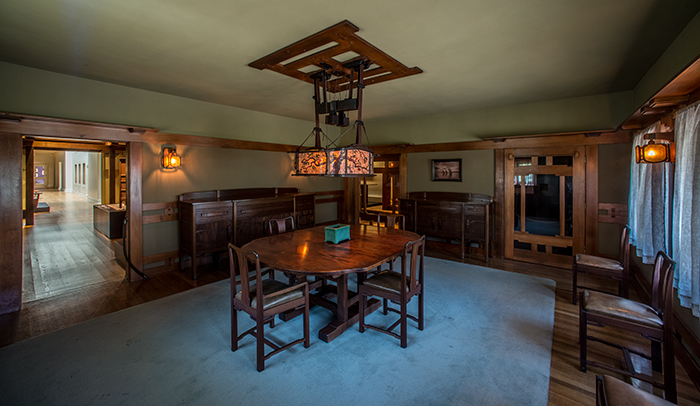
The dining room from the 1906 Robinson house now physically and visually connects with the Chandler Wing at the end of the hallway.
Visitors to the previous display may recall the re-created dining room of the 1906 Laurabelle A. Robinson house. The lovely table, chairs, two sideboards, and chandelier were the first results of a fruitful partnership between the Greenes and another pair of brothers, furniture makers Peter and John Hall. The Halls’ artistry boosted the sophistication of the Greenes’ furniture to new heights. That dining room is still on view in the new exhibition, along with the reassembled stairway from the 1905 Arthur A. Libby house.
But the rest of the large gallery has been transformed. The objects have been regrouped to give a better a sense of the Greenes’ artistic progression, and two scrims break up the space and frame the scene with large images by Leroy Hulbert, the photographer the Greenes hired to document their work. The first scrim shows the exterior of the Gamble House. In front of the photo are a few precious items borrowed from within the house itself.
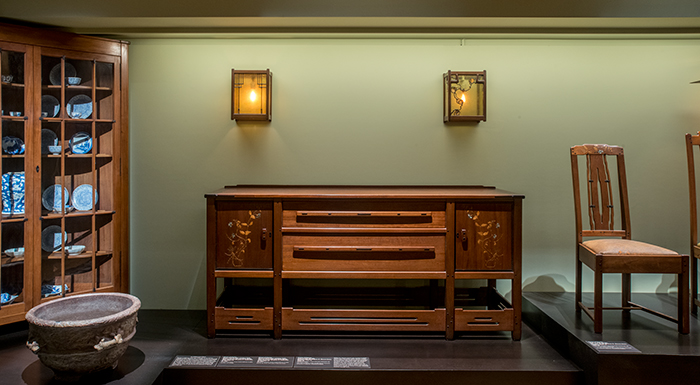
The sideboard and side chair from the 1909 Thorsen house in Berkeley, Calif. with above them two wall lanterns made for the 1902 James A. Culbertson house.
A 1909 chiffonier has been brought out from a dark corner of the Gamble’s master bedroom to The Huntington to better showcase its luminous black walnut and ebony finish, inlaid with fruitwood and semi-precious stones. This single piece set the Gambles back more than $850—a price that would have paid for a small cottage in 1909 dollars. (That figure appears on a list contained within the Greene & Greene Archives, which is housed at The Huntington and owned and administered by the Gamble House, USC.)
Curators chose to display the chiffonier, and a few other objects, at an angle—so that visitors could better examine the chiffonier’s superior craftsmanship from all sides. There is also a chair from the Gamble’s master bedroom with the same motif.
The other large photographic scrim shows the dining room of the 1909 William R. Thorsen house in Berkeley, Calif. A spectacular sideboard appears in the 1915 image, and the real object stands just a few feet away from it. Look closely to see the periwinkle design made from abalone, vermillion, and ebony. Vinca minor grows abundantly in Southern California, and Bosley imagines that Charles Greene pulled a piece of the vine out of his yard one day and placed it on his drafting table. Voilá—his new motif.
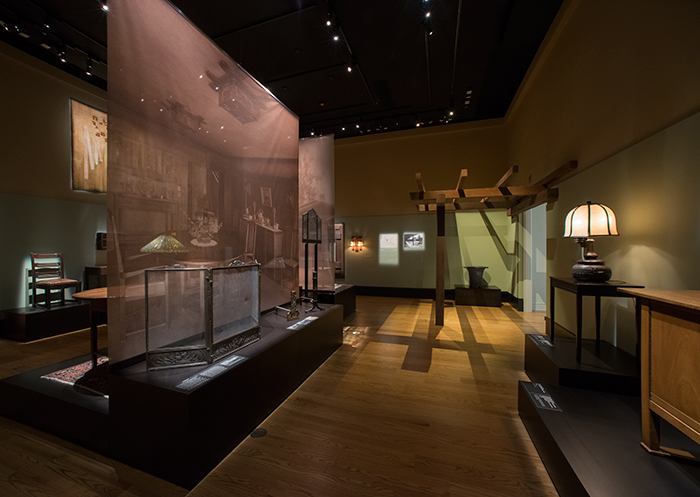
An image of the dining room of the Thorsen house appears on the left with examples of the Greene’s metalwork in front of it. In the background is the recreated fragment of a pergola from the 1903 Arturo and Helen Bandini house.
Another object of particular interest is a re-created fragment of a pergola from one of the Greenes’ earlier commissions, the Arturo and Helen Bandini house (1903). This was a pivotal moment in the architectural development of the Greenes, who had arrived in Pasadena 10 years before and, with this project, truly began designing for the California climate and lifestyle. (McLeod and Bosley created the pergola for the 2009 exhibition “A ‘New and Native’ Beauty: The Art and Craft of Greene & Greene” and brought it back for this installation.)
To give a sense of the breadth of the Greenes’ artistic vision, the installation displays stained- glass windows, lanterns, sconces, lamps, chandeliers, rugs, and andirons, as well as a treasure trove of furnishings, some brought out of storage and some on long-term loan from collectors. The objects hail from more than half a dozen homes (most in Southern California) that the Greenes designed for clients James Culbertson (1902), Jennie Reeve (1903), Adelaide Tichenor (1904), Freeman A. Ford (1906), William T. Bolton (1906), Robert R. Blacker (1907), and others.
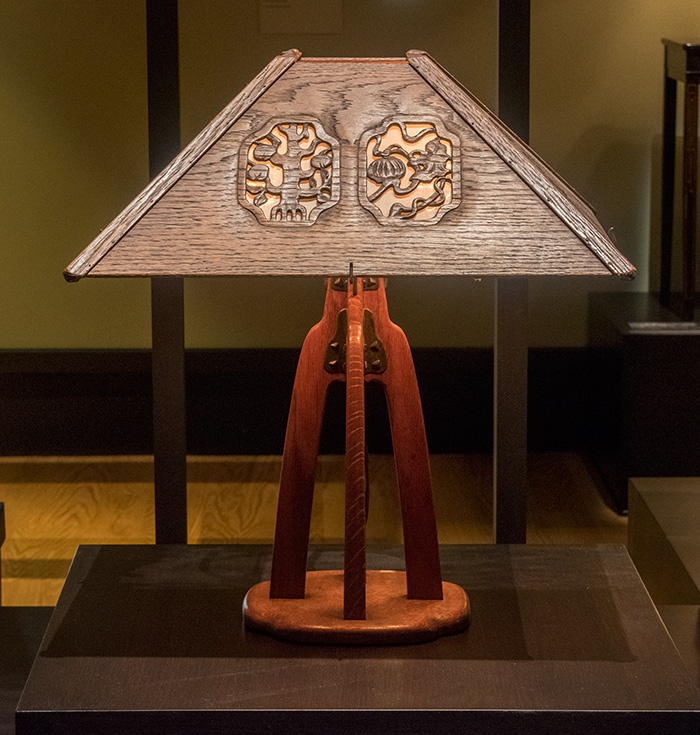
The Greenes’ attention to detail is legendary. This table lamp, made for the den of the Laurabelle A. Robinson house, is crafted from red oak and silk.
Objects new to the installation include a dining room side chair from the Bolton house and a dazzling fire-screen from the Thorsen house made of steel and with repoussé detailing. An object prized both for its beauty and its provenance is a corner cabinet with glass panels that Charles Greene designed for his own house. It is filled with items from his collection of Japanese Imari ceramic ware.
The hallway between the Robinson dining room and the Libby staircase now offers additional display space. Curators will present more light-sensitive objects here, such as plans, prints, and photographs, on a temporary basis. On view now are two ink-on-linen drawings for the Charles Millard Pratt House in Ojai, Calif.
Curators are pleased about the reworked entrance to the installation. The recent reconfiguration of the American galleries created a long, wide hallway that visually and physically connects the Greene & Greene exhibition in the Dorothy Collis Brown Wing at one end with the Susan and Stephen Chandler Wing at the other. (Be sure to visit the Chandler Wing to see the exhibition “Yasuhiro Ishimoto: Bilingual Photography and the Architecture of Greene & Greene.”) You now enter the Greene & Greene exhibition through a foyer space made up of a bench built for the Freeman Ford house, a lantern from the front entry porch of the Jennie Reeve house, and three of five casement windows from the Adelaide Tichenor house. The once hidden Greene & Greene collection is now hard to miss.
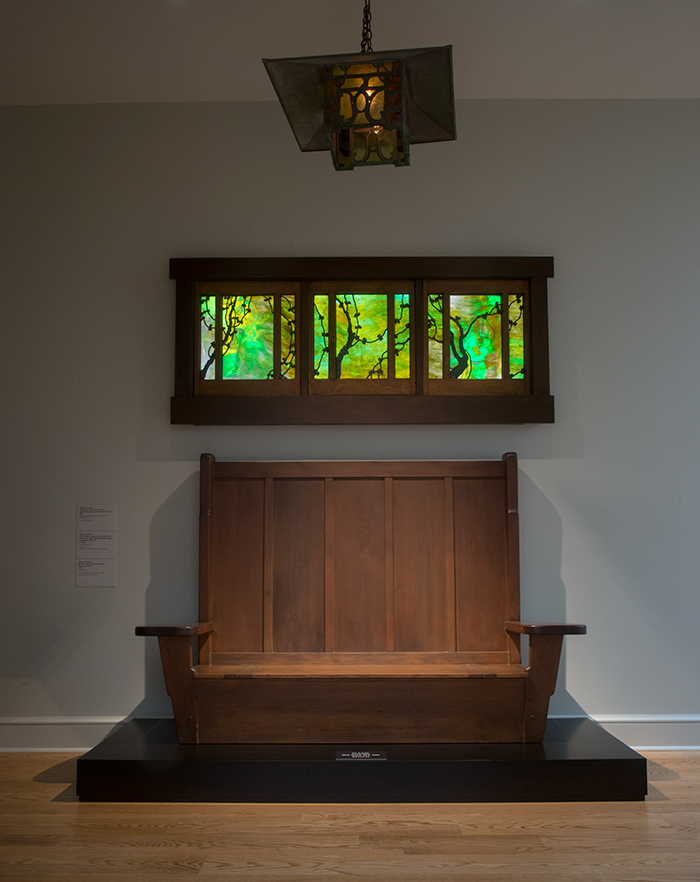
A bench, art glass window, and porch lantern in the entry foyer make it hard to miss the Greene & Greene collection.
Overall, the curators hope that they have succeeded in giving a feel for the Greenes’ artistic process over time. It was a progression that moved quickly, says McLeod. “The development between the simple rustic pergola from the 1903 Bandini house and the refined sophisticated design of the Gamble House, just five years later, is incredible,” she says.
In 1952, the American Institute of Architects honored the Greenes for their “contributions to the design of the American home.” If you want to better understand this accolade, then The Huntington’s new Greene & Greene exhibition is a great place to start.
“Greene & Greene” is on permanent display in the Virginia Steele Scott Galleries of American Art. Just down the hall is “Yasuhiro Ishimoto: Bilingual Photography and the Architecture of Greene & Greene,” on view through Oct. 3, 2016. In the Fall/Winter 2008 issue of Huntington Frontiers, you can read an article by Ann Scheid about the images photographer William Current took of Greene & Greene works, which are part of the Greene & Greene Archives. (Click here for pdf.)
Related content on Verso:
Found in Translation (June 16, 2016)
Diana W. Thompson is senior writer in the office of communications and marketing at The Huntington.
